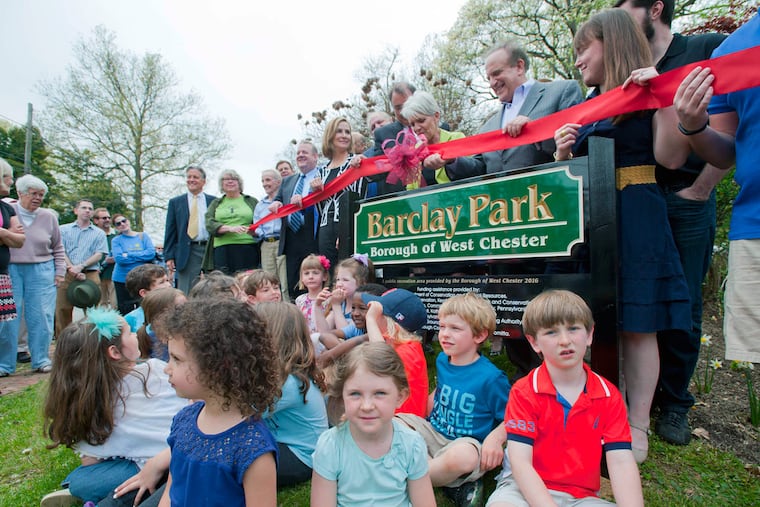In Chesco, an issue of population growth vs. open space
Even as the region continues to gain population in the next two decades, regional planners envision big gains in another area: protected open space.

Even as the region continues to gain population in the next two decades, regional planners envision big gains in another area: protected open space.
In fact, they would like to see those gains far outpace any population growth, from the current 550,000 acres in Philadelphia and its neighboring counties, to 1 million, or about 42 percent of all the region's land.
But the population and development boom in Chester County - which expects to add nearly 150,000 residents by 2045, a 28 percent increase - could present challenges to that goal, and last week county officials began a two-year planning process to figure out how to manage that growth in one of the state's fastest-growing counties.
The strategy includes continuing to direct development toward already well-populated areas - the likes of Phoenixville Borough - and Tom Daniels, professor of city and regional planning at the University of Pennsylvania, says that is a sound idea.
"If they don't pursue a policy of more compact and concentrated development, they're really going to sprawl all over the place," he said.
Before county officials adopted their comprehensive plan in 1996, 8 percent of the county's land was permanently protected open space. Now, nearly 27 percent, or 129,800 acres, is permanently preserved, according to county leaders. By 2019, they want to increase that number to 30 percent.
From there, said Bill Gladden, director of the county's Department of Open Space Preservation, the county will have to decide what to do next. Open space can come with a price, said Jeff Curtis, business manager at the Octorara Area School District.
His district has a harvest of farmland that yields tax breaks for some property owners, thus less money for schools and governments, and higher tax rates for other residents. Octorara is among districts in the southern and southwestern portions of the county with a high percentage of such properties.
Open-space advocates counter that less development means fewer students crowding schools and is a boon to property values.
The Philadelphia region as a whole has shown a "strong desire to preserve open space," said Michael Boyer, associate director of planning at the Delaware Valley Regional Planning Commission, which covers the eight-county area, plus Mercer County.
"As the region grows, we will have to expand our footprint, but we try to limit that," Boyer said.
As Penn's Daniels advised, the planning commission is encouraging county and town officials to focus development in areas already set up to accommodate it. The agency is promoting development in 120 city and town centers throughout the region, including Center City; University City; Ambler, Montgomery County; Haddonfield, Camden County; Kennett Square, Chester County, and King of Prussia.
"Luckily, over the last five to 10 years, we've seen a real growth in people wanting to live in urban centers," Boyer said.
Chester County has invested $49 million for infrastructure improvements in its 15 boroughs and the city of Coatesville. In recent years, those areas have added more than 10,000 residents to their downtowns.
Phoenixville has been preparing for growth for years. Local officials rewrote their comprehensive plan in 2011 and streamlined their zoning laws in 2013. E. Jean Krack, the borough manager, anticipates that the borough council will approve a new subdivision land-development ordinance next month.
About 2,900 additional housing units are on the way, adding to the current 7,600, Krack said.
"That means there's not 2,900 more housing units in the areas where open space is," Krack said. "If you magnify that by 15 boroughs and the city of Coatesville, that's a huge impact."
Phoenixville and several other boroughs are conducting traffic and parking studies.
West Chester, the county seat, has been focused on shoring up its roads, sewer system, water system, natural gas lines, and other infrastructure, said Michael Cotter, West Chester's borough manager.
"We're at the beginning of a big phase of redevelopment here in town," he said. "We're working hard to make sure we're ahead of the wave and ready for all that."
Chester is one of only a handful of counties, along with Philadelphia, whose growth is expected to exceed 20 percent by midcentury, but the planning commission expects its nine counties to grow 11.5 percent, or by about 660,000 people.
Residents in each county must answer fundamental questions about the future, said Rick Schuettler, executive director of the Pennsylvania Municipal League, a nonprofit that advocates for local governments.
"What does the community want to look like?" Schuettler asked. "What does it want to be?"
Brian O'Leary, executive director of the Chester County Planning Commission, said the projected growth in Chester County is a good thing as long as it occurs "in a way that best protects the sense of place in the county."
610-313-8207@MichaelleBond